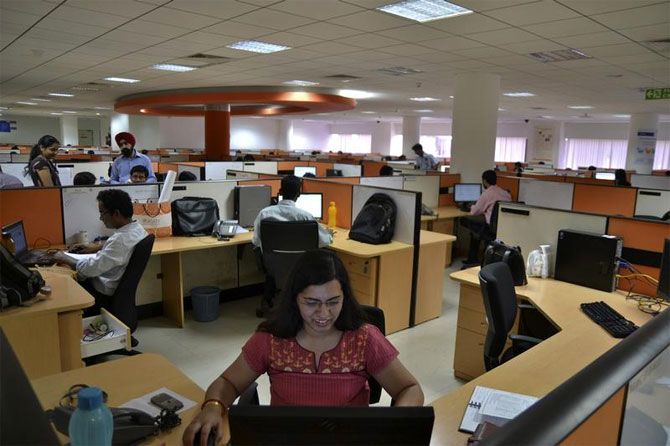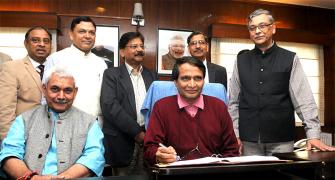
Current Status
India is the world's largest sourcing destination for the information technology industry, accounting for approximately 67% of the $124-130 billion market.
The industry employs about 10 million workforce.
More importantly, the industry has led the economic transformation of the country and altered the perception of India in the global economy.
India's cost competitiveness in providing IT services, which is approximately 3-4 times cheaper than the US, continues to be the mainstay of its unique selling proposition in the global sourcing market.
However, India is also gaining prominence in terms of intellectual capital with several global IT firms setting up their innovation centres in India.
The IT industry has also created significant demand in the Indian education sector, especially for engineering and computer science.
The Indian IT and ITeS industry is divided into four major segments -- IT services, business process management, software products and engineering services, and hardware.
The IT-BPM sector in India grew at a Compound Annual Growth rate of 15% over 2010-15, which is 3-4 times higher than the global IT-BPM spend, and is estimated to expand at a CAGR of 9.5% to $ 300 billion by 2020.
The Indian Information Technology sector is expected to grow 11% per annum and triple its current annual revenue to reach $ 350 billion by FY 2025, as per National Association of Software and Services Companies.
India, the fourth largest base for new businesses in the world and home to over 3,100 tech start-ups, is set to increase its base to 11,500 tech start-ups by 2020, as per a report by Nasscom and Zinnov Management Consulting Pvt Ltd. India’s internet economy is expected to touch Rs 10 trillion ($ 151.6 billion) by 2018, accounting for 5% of the country’s gross domestic product, according to a report by the Boston Consulting Group and Internet and Mobile Association of India.
India’s Internet user base reached over 350 million by June 2015, the third largest in the world, while the number of social media users grew to 143 million by April 2015 and smartphones grew to 160 million.
Industry Expectations
- Provide relief from Service tax and VAT double taxation
Indian IT sector has sought relief from double taxation on software products, and provide cushion to the industry in view of protectionist measures being taken in the global. Environment.
Government levies service tax on a software of foreign source downloaded from internet while both VAT and service tax are levied on software purchased domestically.
IT sector has asked the government to provide level playing field between the two.
Almost all Indian IT companies would have to pay between $8,000 and $10,000 per H-1B visa from April 1 when the next filing session starts, because of various levies imposed on them.
The IT players also urged the Finance Minister to provide them staggered payment option to employees which companies are required to make under a notification issued by Labour Ministry on bonus payment, effective since April 1.
IT companies have also requested for one-time relief for measures being taken in the aftermath of Chennai floods, with regard to benefits being given to employees like relief rehabilitation measures.
- Restore the exemption from MAT for SEZ units
SEZ Act was enacted to boost growth and identified areas were notified as SEZ which were provided host of tax benefits which included exemption from MAT and DDT. However this exemption was withdrawn in the 2011 budget.
Due to removal of exemption from MAT for SEZ units today IT Industry is struggling to utilise the MAT Credit lying in its Balance Sheet. FM to restore the exemption from MAT for SEZ units.
Dividend Distribution Tax: The exemption from paying DDT by SEZ developers may be restored.
Though India continues to be net exporter of goods and services, the rate of growth on export has substantially declined. Hence MAT exemption on profits from exports should be reintroduced.
Further MAT should be exempted for all Companies Formed under section 25 incorporated for doing Educational/Charitable work.
The existing provisions of the Income-tax Act do not specify whether MAT credit will be available to the amalgamated/merged entity on merger.
It is recommended to insert a specific provision in the Act for carry forward of the MAT credit by the amalgamated/merged company in case of amalgamation or merger.
- Allow Foreign Tax Credits on aggregate basis: Currently, foreign tax credit is granted with reference to the provisions of the Double taxation Avoidance Agreements, which are bi-lateral.
Thus, foreign tax credits are claimed and granted following a country-by-country approach, which operate inefficiently when foreign sourced income are derived from a number of countries.
FTC be allowed for taxes on income levied by overseas provincial/local tax jurisdictions.
Assesses be allowed to carry forward the ‘unutilised’ foreign tax credit for 5 years. Clarity with respect to availability of FTC against MAT and the mechanical computation of MAT credit with FTC should be clarified so that next generation of litigation on FTC can be avoided.
- Formulate Transfer pricing guidelines on various issues affecting the industry
Formulate a tax force comprising of representatives from industry and revenue to debate on various issues and issue guidelines which is a binding force on revenue and tax payers.
Review the safe harbour provisions and come out with revised safe harbour provisions so that litigation can be minimised.
- Extend Deduction under Section 35(2AB) of the Income Tax Act to Computer Software
Currently, weighted deduction of 200% is available for expenditure incurred on scientific research on in-house research and development facility as approved by Department of Scientific & Industrial Research.
The deduction is available to a company engaged in the business of bio-technology or in any business of manufacture or production of any article or thing.
There is an ambiguity whether in-house Research & Development facility for computer software is covered within the ambit of section 35(2AB) and whether the software product should be eventually owned by the company.
It should be provided explicitly in the Act that the benefits of weighted deduction under section 35(2AB) of the Act are also available to companies engaged in the manufacture of ‘computer software’. The definition of computer software for the purpose of this section should be the same as provided under Explanation 2 to section 10A of the Act.
- Allow Weighted Deduction on Skill Development Expenditure
To promote skill development in the IT sector, weighted deduction on skill development expenditure incurred by IT companies should also be made eligible for deduction under section 35CCD of the Act.
- Parity in the Treatment of Export Turnover and Total Turnover
The term ‘total turnover’ has not been defined in the Act. The tax authorities do not provide parity in the treatment of the term ‘Export Turnover’ (‘ET’) and ‘Total Turnover’ (‘TT’) for the purpose of computation of deduction under sections 10A/10AA/10B of the Act.
Hence, certain items which are excluded while computing the ET are not excluded from the TT, thereby distorting the figure of ET/TT. It is recommended that definition of total turnover should be clearly provided in the Act and which should be in parity with the definition of export turnover (in relation to exclusion of certain items).
- Clear Guidelines on Attribution of Profits to Permanent Establishment
Many a times, a Permanent Establishment (‘PE’) of foreign enterprises is alleged by the tax authorities on account of mere procurement of orders for sale of goods or provision of services or answering sales related queries, etc.
These are routine services outsourced to Indian enterprises.
Provision of these services is the backbone of IT/ITeS sector in India for which they get remunerated at Arm’s Length Price (‘ALP’).
Foreign investors/companies are losing interest to invest in India since there is a tendency of the tax authorities to allege that the Indian entity is a PE of the foreign entity.
They also fear attribution of profits of the foreign entity to such an alleged PE.
This is in-spite of the fact that Indian entity is remunerated at ALP by the foreign company and such ALP is accepted during transfer pricing audit of the Indian entity. It is recommended that the Act should categorically provide that no further profits can be attributed to PE, if PE is remunerated on arm’s length basis.
- Corporate tax rate reduction
The other key monitorable from an IT sector standpoint in this year’s Budget is the roadmap for implementation of corporate tax rate reduction from 30% to 25%, which was indicated in the previous Budget.
Stock to watch
TCS, Infosys, Oracle Financial, Tech Mahindra, Wipro
Outlook
There is plenty of buzz around the financial technology both in terms of getting big ticket investments as well as the widening of the 'transaction' system.
The Budget could spell out the financial environment in which these could thrive and grow.
Incentivising innovation in this space can considerably spur start-ups.
These are just a few of the demands from the government in the Budget.
It would be pretty useful to have simple norms, less regulation and faster execution to support what's a vibrant start-up ecosystem.
With a large number of players entering digital payments space, Budget could shed light on how this area would be developed further given the large numbers using it. Comments on digital banking, peer-to-peer transfers and other new-age mobile payment concepts should get some direction from the government.
The alternate transactional sector in the upcoming Budget will give digital commerce a big boost and is hoping special comments in the Budget.
Duality of pressure in traditional services and growing opportunity in emerging technologies have been impacting companies based on portfolios and strategies. Margins are under pressure in the near-term led by optimum utilisation, increased S&M investments and changing business mix.
Indirectly, inflation (and consequently wage hikes) and differential inflation (leading to movement of INR versus developed market currencies) does play a role in determining margins and earnings of Technology outsourcing companies.
INR depreciation over the years has been a big tailwind which helped the industry partially offset wage hike pressure.
Macro-economic stability does lead to lower INR depreciation (on a relative basis) with respect to a number of customer market currencies.
Any destabilising moves in the Budget could lead to INR depreciation and aid the earnings of the sector.
However, such moves can also drive FPIs out of India, leading to P/E multiple compression.
The image is used for representational purpose only. Photograph: Reuters









